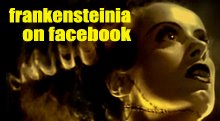
Fred Passmore at Monster Memories has unearthed an interview with Elsa Lanchester — The Bride of Frankenstein herself — originally published in Marvel’s Monster of the Movies magazine in 1975. It’s a short, lightweight exchange with editor Jim Harmon and radio host Frank Bresee. You wish some film historian had sat down and properly grilled Ms Lanchester, but still, there are some interesting bits here.
Lanchester recalls how make-up chores on Bride of Frankenstein entailed “very long hours”, with Jack Pierce spending four or five hours on Karloff’s Monster and then three or four more on The Bride. “Boris would start at about half past two in the morning, and I came in about half past five.”
The pair would work a few hours and be released early so as to get enough rest to start over again in the wee hours of the following day.

The actress remembers Karloff as “a very, very intelligent man” and lends credence to stories of director Whale being less than kind with his monster star, saying, “James Whale treated him like a truck driver, when Boris was a sophisticated, educated man. He was a very nice person.”
The most tantalizing quote from the interview comes when Lanchester says she would have returned to the part if The Bride had been revived.
“Oh yes, I would have stayed with it. I wasn’t thinking about type-casting then.” Boris Karloff, she says, “had a lot to live down as an actor because he was thought of only as the Monster. I was sort of a spiritual bride, so that never attached to me.”
It’s fun to know that Elsa Lanchester would have donned The Bride’s electric beehive again if asked — “It would be interesting to do an elderly Bride”, she says — but the character's short and spectacular film career, barely 12 minutes onscreen, makes her that more magical, that more special and unforgettable. Universal’s Monster would be revived often, pulled from castle ruins, yanked out sulfur pits and chipped out of ice walls, given less to do with every reanimation, becoming a prop in late 40’s Monster rallies. The Bride flashed across the screen and our consciousness like a speeding comet, leaving an indelible afterglow, never to be dimmed in a parody of reanimation.

Elsa Lanchester’s life was an extraordinary one. She studied dance under Isadora Duncan, she was married to Charles Laughton, she earned two Oscar nominations, and she sang a duet with Elvis Presley. She played both Mary Shelley and The Monster’s betrothed in Bride of Frankenstein. She excelled at comedy. With time, she wore her age well, growing older in roles that suited her without the artifice of youth displayed by many of her contemporaries. She was feisty, eccentric, and a joy to watch, always.
There’s plenty to admire and remember in her work, but The Bride made her a cinema immortal.
You can read the whole interview, scanned from the pages of Monster of the Movies, on Monster Memories.
A profile of Elsa Lanchester on Cult Sirens.
Related:
The Short, Apocalyptic Life of The Bride of Frankenstein








































